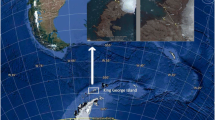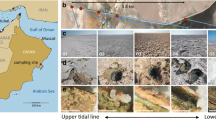Abstract
Rann of Kachchh (RoK) is a unique geoformation, which is exposed to dynamic environmental changes such as salinity, temperature, and nutrients throughout the year. In this study, the pooled mat sample was examined for the cyanobacterial community structure using culture-dependent and culture-independent approaches. Taxonomic profiling was studied using amplicon sequencing that revealed the enrichment of Pseudanabaenales and Oscillatoriales by QIIME and MG-RAST, respectively. Other abundant orders were represented by Chroococcales, Nostocales, and unclassified cyanobacteria by both approaches. Nine cyanobacterial cultures were isolated from mat samples showing 90–98% similarities with available sequences in GenBank. The culture-dependent study suggested that mat was dominated by cyanobacterial orders such as Oscillatoriales—filamentous and Chroococcales—unicellular. Our results from the culture-dependent approach also indicated that despite high similarities in gene sequences, six cyanobacteria fall into the separate clade in the phylogenetic analysis that could be signs of evolution due to an extreme environment. Cultured isolates are correlated well with abundant taxa from amplicon sequencing. Further, protein profiling was done specifically for phycobiliproteins which will be helpful to elucidate their roles in light harvesting and energy transfer mechanism in the unique environment of RoK.







Similar content being viewed by others
Abbreviations
- MG-RAST:
-
Meta Genome Rapid Annotation using Subsystem Technology
- OTU:
-
Operational taxonomic units
- PBP:
-
Phycobiliproteins
- QIIME:
-
Quantitative insights into microbial ecology
- RoK:
-
Rann of Kachchh
References
Abed RM, Klempová T, Gajdoš P, Čertík M (2015) Bacterial diversity and fatty acid composition of hypersaline cyanobacterial mats from an inland desert Wadi. J Arid Environ 115:81–89
Andreote APD, Vaz MGMV, Genuário DB, Barbiero L, Rezende-Filho AT, Fiore MF (2014) Nonheterocytous cyanobacteria from Brazilian saline–alkaline lakes. J Phycol 50:675–684
Bahl J et al (2011) Ancient origins determine global biogeography of hot and cold desert cyanobacteria. Nat Commun 2:163
Bennett A, Bogorad L (1973) Complementary chromatic adaptation in a filamentous blue-green alga. J Cell Biol 58:419–435
Bergman B, Gallon J, Rai A, Stal L (1997) N2 fixation by non-heterocystous cyanobacteria. FEMS Microbiol Rev 19:139–185
Bhatnagar A, Makandar M, Garg M, Bhatnagar M (2008) Community structure and diversity of cyanobacteria and green algae in the soils of Thar Desert (India). J Arid Environ 72:73–83
Bolhuis H, Cretoiu MS, Stal LJ (2014) Molecular ecology of microbial mats. FEMS Microbiol Ecol 90:335–350
Caporaso JG et al (2010) QIIME allows analysis of high-throughput community sequencing data. Nat Methods 7:335–336
Chrismas NA, Williamson CJ, Yallop ML, Anesio AM, Sánchez-Baracaldo P (2018) Photoecology of the Antarctic cyanobacterium Leptolyngbya sp. BC1307 brought to light through community analysis, comparative genomics and in vitro photophysiology. Mol Ecol 27:5279–5293
Cowan DA, Sohm JA, Makhalanyane TP, Capone DG, Green T, Cary S, Tuffin I (2011) Hypolithic communities: important nitrogen sources in Antarctic desert soils. Environ Microbiol Rep 3:581–586
Dadheech PK, Abed RM, Mahmoud H, Mohan MK, Krienitz L (2012) Polyphasic characterization of cyanobacteria isolated from desert crusts, and the description of Desertifilum tharense gen. et sp. nov. (Oscillatoriales). Phycologia 51:260–270
Desai C, Madamwar D (2007) Extraction of inhibitor-free metagenomic DNA from polluted sediments, compatible with molecular diversity analysis using adsorption and ion-exchange treatments. Bioresour Technol 98:761–768
Edgar RC, Haas BJ, Clemente JC, Quince C, Knight R (2011) UCHIME improves sensitivity and speed of chimera detection. Bioinformatics 27:2194–2200
Fagliarone C, Mosca C, Ubaldi I, Verseux C, Baqué M, Wilmotte A, Billi D (2017) Avoidance of protein oxidation correlates with the desiccation and radiation resistance of hot and cold desert strains of the cyanobacterium Chroococcidiopsis. Extremophiles 21:981–991
Falkowski PG (1997) Evolution of the nitrogen cycle and its influence on the biological sequestration of CO2 in the ocean. Nature 387:272–275
Fiore MF, Moon DH, Tsai SM, Lee H, Trevors JT (2000) Miniprep DNA isolation from unicellular and filamentous cyanobacteria. J Microbiol Methods 39:159–169
Fund WW (2014) Rann of Kutch seasonal salt marsh
Garrity GM, Holt JG (2001) The road map to the manual. Bergey’s Manual® of systematic bacteriology. Springer, Berlin, pp 119–166
Genuario DB, Andreote APD, Vaz MGMV, Fiore MF (2017) Heterocyte-forming cyanobacteria from Brazilian saline-alkaline lakes. Mol Phylogenetics Evol 109:105–112
Giovannoni S, Turner S, Olsen G, Barns S, Lane D, Pace N (1988) Evolutionary relationships among cyanobacteria and green chloroplasts. J Bacteriol 170:3584–3592
Hoehler TM, Bebout BM, Des Marais DJ (2001) The role of microbial mats in the production of reduced gases on the early Earth. Nature 412:324–327
Hoffmann L, Komárek J, Kaštovský J (2005) System of cyanoprokaryotes (cyanobacteria)—state in 2004. Algol Stud 117:95–115
Hugenholtz P, Goebel BM, Pace NR (1998) Impact of culture-independent studies on the emerging phylogenetic view of bacterial diversity. J Bacteriol 180:4765–4774
Komárek J, Anagnostidis K (2005) Cyanoprokaryota. 2. Teil. Part: oscillatoriales
Kumar D, Adhikary SP (2015) Diversity, molecular phylogeny, and metabolic activity of cyanobacteria in biological soil crusts from Santiniketan (India). J Appl Phycol 27:339–349
Kumar S, Stecher G, Li M, Knyaz C, Tamura K (2018) MEGA X: molecular evolutionary genetics analysis across computing platforms. Mol Biol Evol 35:1547–1549
Lacap-Bugler DC et al (2017) Global diversity of desert hypolithic cyanobacteria. Front Microbiol 8:867
Magoč T, Salzberg SL (2011) FLASH: fast length adjustment of short reads to improve genome assemblies. Bioinformatics 27:2957–2963
McDonald D et al (2012) An improved Greengenes taxonomy with explicit ranks for ecological and evolutionary analyses of bacteria and archaea. ISME J 6:610–618
Meyer F et al (2008) The metagenomics RAST server–a public resource for the automatic phylogenetic and functional analysis of metagenomes. BMC Bioinf 9:386
Mogany T, Swalaha FM, Allam M, Mtshali PS, Ismail A, Kumari S, Bux F (2018) Phenotypic and genotypic characterisation of an unique indigenous hypersaline unicellular cyanobacterium Euhalothece sp. nov. Microbiol Res 211:47–56
Narayan A et al (2018) Response of microbial community structure to seasonal fluctuation on soils of Rann of Kachchh, Gujarat, India: representing microbial dynamics and functional potential. Ecol Genet Genom 6:22–32
Olsson-Francis K, de la Torre R, Cockell CS (2010) Isolation of novel extreme-tolerant cyanobacteria from a rock-dwelling microbial community by using exposure to low Earth orbit. Appl Environ Microbiol 76:2115–2121
Pandit AS et al (2015) A snapshot of microbial communities from the Kutch: one of the largest salt deserts in the World. Extremophiles 19:973–987
Patel HM, Rastogi RP, Trivedi U, Madamwar D (2018) Structural characterization and antioxidant potential of phycocyanin from the cyanobacterium Geitlerinema sp. H8DM. Algal Res 32:372–383
Pointing SB, Warren-Rhodes KA, Lacap DC, Rhodes KL, McKay CP (2007) Hypolithic community shifts occur as a result of liquid water availability along environmental gradients in China’s hot and cold hyperarid deserts. Environ Microbiol 9:414–424
Ramos V et al (2017) Cyanobacterial diversity in microbial mats from the hypersaline lagoon system of Araruama, Brazil: an in-depth polyphasic study. Front Microbiol 8:1233
Rastogi R, Sonani R, Madamwar D (2017) UV photoprotectants from algae—synthesis and bio-functionalities. Algal green chemistry. Elsevier, Amsterdam, pp 17–38
Reddy YP, Yadav RK, Abraham G (2018) Screening of cyanobacterial isolates from Rann of Kutch for the production of mycosporine like amino acids. IJCS 6:1639–1645
Rideout JR et al (2014) Subsampled open-reference clustering creates consistent, comprehensive OTU definitions and scales to billions of sequences. PeerJ 2:e545
Silva CSP, Genuário DB, Vaz MGMV, Fiore MF (2014) Phylogeny of culturable cyanobacteria from Brazilian mangroves. Syst Appl Microbiol 37:100–112
Singh NK, Sonani RR, Rastogi RP, Madamwar D (2015) The phycobilisomes: an early requisite for efficient photosynthesis in cyanobacteria. EXCLI J 14:268–289
Strunecký O et al (2019) High diversity of thermophilic cyanobacteria in Rupite hot spring identified by microscopy, cultivation, single-cell PCR and amplicon sequencing. Extremophiles 23:35–48
Tiwari O, Singh B, Mishra U, Singh A, Dhar DW, Singh P (2005) Distribution and physiological characterization of cyanobacteria isolated from arid zones of Rajasthan. Trop Ecol 46:165–171
Tracy CR, Streten-Joyce C, Dalton R, Nussear KE, Gibb KS, Christian KA (2010) Microclimate and limits to photosynthesis in a diverse community of hypolithic cyanobacteria in northern Australia. Environ Microbiol 12:592–607
Tringe SG, Hugenholtz P (2008) A renaissance for the pioneering 16S rRNA gene. Curr Opin Microbiol 11:442–446
Vogt JC, Abed RM, Albach DC, Palinska KA (2018) Bacterial and archaeal diversity in hypersaline cyanobacterial mats along a transect in the intertidal flats of the Sultanate of Oman. Microb Ecol 75:331–347
Wang Q, Garrity GM, Tiedje JM, Cole JR (2007) Naive Bayesian classifier for rapid assignment of rRNA sequences into the new bacterial taxonomy. Appl Environ Microbiol 73:5261–5267
Waterbury JB, Stanier RY (1981) Isolation and growth of cyanobacteria from marine and hypersaline environments. The prokaryotes. Springer, New York, pp 221–223
Wierzchos J, Ascaso C, McKay CP (2006) Endolithic cyanobacteria in halite rocks from the hyperarid core of the Atacama Desert. Astrobiology 6:415–422
Wilmotte A, Herdman M (2001) Phylogenetic relationships among the cyanobacteria based on 16S rRNA sequences. Bergey’s Manual of Systematic Bacteriology Volume One: The Archaea and the Deeply Branching and Phototrophic Bacteria 487–493
Yang B, Wang Y, Qian PY (2016) Sensitivity and correlation of hypervariable regions in 16S rRNA genes in phylogenetic analysis. BMC Bioinf 17:135
Acknowledgments
DM acknowledges to University Grants Commission (UGC), New Delhi for providing financial support under UGC-BSR Faculty Fellowship and Department of Biotechnology, New Delhi (BT/PR15686/AAQ/3/811/2016). RPR is grateful to the University Grants Commission (UGC), New Delhi, India for the Dr. D. S. Kothari Postdoctoral Research Grant.
Author information
Authors and Affiliations
Corresponding author
Ethics declarations
Conflict of interest
The authors declare that they have no competing interests.
Electronic supplementary material
Below is the link to the electronic supplementary material.
Rights and permissions
About this article
Cite this article
Patel, H.M., Rastogi, R.P., Trivedi, U. et al. Cyanobacterial diversity in mat sample obtained from hypersaline desert, Rann of Kachchh. 3 Biotech 9, 304 (2019). https://doi.org/10.1007/s13205-019-1837-y
Received:
Accepted:
Published:
DOI: https://doi.org/10.1007/s13205-019-1837-y




